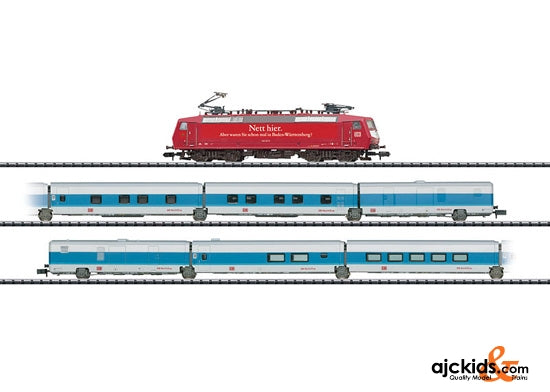Trix 11636 - DB AG Night Train to the Homeland Train Set
Prototype: German Railroad, Inc. (DB AG) express locomotive, road number 120 140-9 with the advertising printing "Nett hier." / "Nice here." B-B wheel arrangement. Built starting in 1987.
Use: First class long-distance service, here arranged as a Talgo night train. 6 German Railroad, Inc. (DB AG) Talgo design hotel cars. Version for the DB Nachtzug / Night Train. 2 end cars (Machinery Cars I and II), 2 dining cars (Lounge and Bistro), and 2 sleeping cars (1st class). The cars are completely painted and lettered in the design of the DB Nachtzug / Night Train.
Model: The locomotive has a digital interface connector. It also has a motor with a flywheel. 4 axles powered. 2 traction tires. The locomotive has a close coupler mechanism. The headlights and marker lights change over with the direction of travel. The basic paint scheme is "Orient Red", and the paint scheme below the coat-of-arms and the advertising lettering is prototypically done in "Traffic Red". The sleeping cars have articulated running gear with special snap-in coupling between the cars.
Total length over the buffers 592 mm / 23-5/16".
The train comes in a special book packaging for a stylish presentation including placeholders for the T15551 add-on car set to go with this train.
Highlights:
Special book packaging for collectors.
One-time series.
DB Talgo Night Train. In June of 1992, the German Federal Railroad took a daring, unusual step. It ordered a first series of five trains of the TalgoPendular 200 type at a cost of 124 Million German Marks (= 63.3 million Euros) from the Spanish firm Talgo. All of these trains belong to the sixth generation of Talgo design, of which the Talgo prototype from 1942 is the first generation. The Talgo articulated trains are the discovery of the Spanish engineer Alejandro Goicoechea, who wanted to compensate for the disadvantages of heavy passenger cars that were hard on track by coming up with a new car concept. In 1942, Goicoechea founded together with the financier Oriol the firm Patentes Talgo S.A. in Madrid and presented a first prototype in the shape of the Talgo I with articulated, three-point mounted car elements and single wheels. "Talgo" stands for "Trenarticuladoligero Goicoechea Oriol" (= Lightweight articulated train by Goicoechea and Oriol). With Talgo, each car body has a single wheel truck only at one end, while the other end is supported by an adjoining car. Only the leading end car has two trucks. The short car bodies cause the stub end axles for the wheels to act almost radially on curves so that the wheel flanges rub less against the rails compared to conventional cars and thus cause less rail wear. This design allowed the Talgo trains to roll rather lightly and quietly on curves. The basic concept of the Talgo trains was not changed over the years but was developed further of course. These were radial running gear steering, the passive tilt body ability "TalgoPendular", as well as the "Talgo RD" adjustable running gear for different gauges. The running gear and the tilt body technology on the DB's "TalgoPendular" are closely tied to one another in terms of design. The radial controlled single wheel running gear has air springs beneath the roof. This high-mounted spring arrangement together with the car body suspension leads to a turning of the car body around a virtual pivot axis that is above the roof. The centrifugal forces that occur when negotiating a curve tilts the car body up to 3.5 degrees to the outside of the curve and thereby reduces considerably the side forces affecting the passengers. The first series delivered comprised 112 cars and regularly scheduled Talgo service was initiated in Germany with the start of the summer schedule on May 29, 1994. These Talgo Night Trains ran in Germany initially as InterCityNight (ICN), later as DB Nachtzug (NZ), and at the end as DB CityNightLine (CNL) between Berlin and Munich, between Munich and Hamburg as well as between Bonn and Berlin, and between Stuttgart and Hamburg for a time. Each train consisted of a maximum of 22 cars in the categories Comfort Sleeping Car (with shower and toilet in each compartment), Comfort Seating Car with reclining seats (one of the cars suitable for handicapped passengers), Slumber Coaches, Bistro and Reception Cars, Dining Cars as well as two machinery end cars with baggage compartments, bicycle racks, and ski racks. The Talgo trains replaced conventional, locomotive-hauled overnight trains, and four of them were in operation every night. The fifth set served as a reserve. With the delivery of two additional trains in August of 1996, the DB expanded its Talgo use on September 29, 1996 to a six-day turnaround. In December 2008, operation of the Talgo overnight trains ended after 15 years due to costs and to the upcoming cost-intensive main maintenance deadlines.
This train set can be extended as desired with the 15551 add-on car set.
EAN/UPC: 4028106116360



